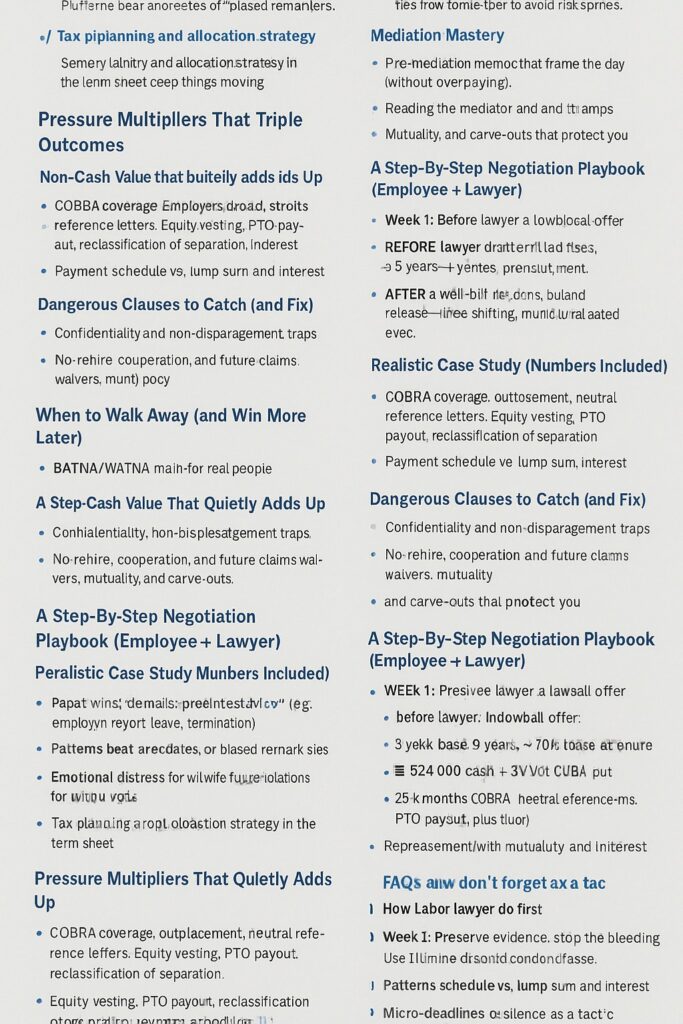How Labor Lawyers Secretly Negotiate 3× Higher Settlements for Wrongful Termination

Introduction: Why Some Employees Get 3× More—And Others Don’t
If you’ve been fired and something about it feels off, you’re not alone. Two people can face nearly the same situation—yet one walks away with a modest check while the other lands a settlement that’s two or three times bigger. What’s the difference? It’s rarely luck. It’s the structure of the negotiation.
Think of a settlement like selling a house. You could list it “as is” for quick cash, or you could stage the rooms, time the market, and bring in a specialist who knows how to attract multiple offers. Labor lawyers do the latter. They don’t just “ask for more.” They engineer leverage—with evidence, timing, valuation, and pressure points—so that paying you more becomes the employer’s smartest option.
In this guide, we’ll unpack the settlement engine lawyers use to reliably increase outcomes—often by 3×—without theatrics or false bravado.
Understanding Wrongful Termination (Plain English)
What qualifies as “wrongful,” not merely “unfair”
“Unfair” is a feeling. “Wrongful” has a legal hook. Most wrongful termination claims tie to:
- Discrimination (e.g., age, sex, race, disability, pregnancy).
- Retaliation (you complained about harassment, safety, or pay and were punished).
- Whistleblowing (you reported illegal conduct).
- Public policy violations (fired for refusing to break the law, taking protected leave, etc.).
Common legal hooks: discrimination, retaliation, whistleblowing, public policy
Your lawyer will test the facts against statutes and case law, then craft a short, credible theory: “They fired her three weeks after she reported wage violations; HR emails show they anticipated a complaint.” That one sentence is the backbone of the entire negotiation.
Settlement Basics Most People Miss
What a settlement actually buys (and sells)
A settlement isn’t just money. It’s peace. Your release buys the employer closure: no lawsuit, no discovery, no public filings, no ongoing PR risk. Understanding that value is key to pricing your claim correctly.
Timing windows that shift negotiating power
Power isn’t static. It shifts:
- Immediately after termination: emotions run hot; employers expect quick, cheap resolutions.
- After a well-built demand: your leverage rises when liability looks real and discovery looks painful.
- Approaching mediation or trial milestones: deadlines create movement; employers pay more to avoid risk spikes.
The Evidence Stack: Building the File That Makes Employers Blink

Paper wins: emails, chats, evaluation trails
Attorneys curate receipts: performance reviews that suddenly turn negative after you complained; Slack logs that show bias; calendar invites proving you were sidelined. One crisp exhibit can beat ten angry paragraphs.
Patterns beat anecdotes: comparators and timelines
Comparators—how others were treated—are gold. So are timelines that show protected activity → adverse action. Lawyers love clean sequences.
The “three exhibits” rule attorneys love
Many demand letters hinge on three killer exhibits:
- A document showing protected activity (complaint, report, leave).
- A document showing adverse action (PIP, demotion, termination) soon after.
- A document revealing inconsistent explanations or biased remarks.
With those three, liability feels real—fast.
Valuation 101: How Lawyers Calculate a Top-Tier Demand
Back pay, front pay, benefits, and bonuses
Start with the wage gap caused by the termination:
- Back pay: lost wages from termination to settlement.
- Front pay: expected future loss until you reasonably land comparable work.
- Benefits/bonuses: health insurance value, 401(k) match, expected annual bonus, commissions.
Emotional distress, liquidated/punitive damages, fee shifting
Depending on the statute, you may also claim:
- Emotional distress (documented therapy/medical notes help).
- Liquidated/punitive damages for willful violations.
- Attorney’s fees (fee-shifting statutes increase employer risk because losing means paying your lawyer too).
Tax planning and allocation strategy in the term sheet
Smart lawyers allocate portions of the settlement (wages vs. non-wage damages vs. fees) to optimize after-tax results and reduce payroll tax exposure where lawful. The allocation should be clear in the agreement.
The Demand Letter That Anchors High (Without Overplaying)
Framing liability in one page
The best demand letters are short and surgical. They frame the story with a tight timeline, cite the right laws, and attach those three exhibits.
The anchor, the rationale, and the off-ramps
Anchoring high isn’t about bravado. It’s about math:
- Present a credible valuation model (back pay + front pay + damages + fees).
- Offer off-ramps (e.g., “We’d consider mediated resolution by [date].”).
- Signal patience: a too-fast deal reads like discount pricing.
Mediation Mastery
Pre-mediation memos that frame the day
Your lawyer sends a confidential memo to the mediator: the facts, the exhibits, the risks. This memo quietly guides the mediator’s shuttle diplomacy all day long.
Reading the mediator and using brackets
Mediators use brackets (“If you come down to X, they’ll go up to Y”) to move parties. Seasoned lawyers pace concessions, avoid big leaps too early, and let the mediator carry hard truths to the other room.
Shuttle diplomacy: how offers “move” when you’re patient
Early offers will be low. That’s normal. Movement accelerates after lunch when fatigue and deadlines set in. Patience pays.
Pressure Multipliers That Triple Outcomes
Discovery burdens employers dread
Employers hate discovery that forces them to:
- Produce manager emails and Slack threads.
- Disclose pay equity data and comparator files.
- Sit for depositions on embarrassing topics.
The credible threat of discovery—costly, time-consuming, and illuminating—pushes numbers up.
Reputational and regulatory risk (subtle, lawful pressure)
You can’t threaten publicity unlawfully, but you can point to court records being public and reference regulatory avenues (e.g., agency charges) that increase oversight. That awareness alone raises settlement value.
Arbitration vs. litigation leverage differences
Arbitration is quieter but not cheap. Filing fees, arbitrator time, and motion practice still cost real money—money employers would rather put toward your settlement.
Non-Cash Value That Quietly Adds Up
COBRA coverage, outplacement, neutral reference letters
Three under-appreciated chips:
- COBRA months paid by employer = several thousand dollars.
- Outplacement coaching = faster re-employment (less front pay).
- Neutral reference protocols ensure HR won’t torpedo your job hunt.
Equity vesting, PTO payout, reclassification of separation
If equity was near a vest date, lawyers sometimes negotiate partial vesting or cash equivalents. Don’t forget unused PTO and “resignation for record” language that helps your narrative.
Payment schedule vs. lump sum and interest
Can’t bridge the gap? Lawyers may structure installments with interest, which quietly increases total value without blowing an annual budget line.
Dangerous Clauses to Catch (and Fix)
Confidentiality and non-disparagement traps
Overbroad clauses can muzzle you for life. Lawyers narrow scope, add mutuality, and carve out truthful statements to regulators, tax authorities, and family/financial advisors.
No-rehire, cooperation, and future claims waivers
“No-rehire” might be fine—or it might harm your industry prospects. Cooperation clauses must be reasonable (no unpaid perpetual consulting). Future claims shouldn’t swallow unrelated rights.
Mutuality and carve-outs that protect you
Mutual non-disparagement, mutual releases, and attorney-fee clauses for breaches keep the peace fairly—not one-sided.
When to Walk Away (and Win More Later)
BATNA/WATNA math for real people
Your BATNA (Best Alternative To a Negotiated Agreement) and WATNA (Worst Alternative) aren’t theoretical. They’re a spreadsheet: time to new job, litigation cost, emotional bandwidth, risk tolerance. Lawyers keep this math visible so you don’t accept a shiny but small number.
Micro-deadlines and silence as a tactic
Short, respectful deadlines focus the other side. Silence after a lowball often does more than a paragraph of outrage.
A Step-By-Step Negotiation Playbook (Employee + Lawyer)

Week 1: Preserve evidence, stop the bleeding
- Save emails, chats, calendars to a personal device (lawfully).
- Write a timeline: complaint date, remarks, performance shifts, termination.
- Don’t vent on social media. Screenshots kill credibility.
Week 2–3: Liability theory + valuation model
- Lawyer drafts a theory grounded in statute and exhibits.
- Build a valuation sheet: back/front pay, benefits, emotional distress, fees.
- Decide forum (agency charge, arbitration, or court) to maximize leverage.
Week 4–8: Demand, mediation, and deal shaping
- Send a tight demand with 2–3 exhibits.
- Enter mediation with a clear floor and ceiling.
- Hammer out terms: tax allocation, confidentiality carve-outs, neutral reference, COBRA, outplacement, equity/PTO, payment timing.
Realistic Case Study (Numbers Included)
Before the lawyer: a lowball offer
- Title: Senior analyst, $90k base, 7 years’ tenure.
- Termination 3 weeks after raising pay equity concerns.
- Employer’s initial offer: $15,000 and a broad release.
After the strategy: tripled outcome and cleaner terms
- Evidence: email chain confirming complaint; calendar showing exclusion from key meetings; Slack message with biased remark.
- Valuation: $35k back pay + $20k front pay + $25k distress + fee risk + benefits.
- Settlement achieved: $52,500 cash + 4 months COBRA + neutral reference + PTO payout + non-disparagement with mutuality + confidentiality carve-outs.
Total effective value ≈ $60k–$65k, 3–4× the initial offer—plus cleaner post-employment optics.
Common Pitfalls That Kill Great Settlements
Emotional emails, social media, and “venting”
Rage-sending and posting are negotiation arson. The other side screenshots everything.
Accepting cash but missing value in terms
A few lines of terms can be worth thousands: reference language, tax allocation, COBRA, payment timing, narrowly tailored confidentiality. Don’t leave them on the table.
Conclusion: What Smart Employees Do First
You don’t get 3× outcomes by accident. You get them by engineering leverage—with a clear liability theory, a disciplined valuation, a demand that anchors credibly, and mediation pressure that escalates employer risk at just the right moments. Sprinkle in non-cash terms that improve your future, fix dangerous clauses, and keep your BATNA math in view. That’s how labor lawyers turn a shaky “maybe” into a confident yes—and why their clients walk away with more money and a cleaner path forward.
FAQs

1) How do I know if my case is strong enough to pursue a high settlement?
If you can show a protected activity (e.g., complaint), adverse action soon after (e.g., termination), and inconsistent explanations or biased remarks, you’ve got the core of a strong theory. A lawyer can test your facts against the right statutes to confirm.
2) Should I accept the first offer if it seems decent?
Usually not. Early offers are information-gathering probes. A structured demand with exhibits, followed by mediation, tends to move numbers significantly.
3) Can non-cash terms really make a big difference?
Absolutely. COBRA months, neutral references, outplacement, tax allocation, and payment schedules can add thousands in real value—and often matter as much as cash.
4) What if my employer forces arbitration?
Arbitration changes the venue, not the leverage math. Discovery still costs money and risk still exists. Many employers prefer to pay to avoid those costs.
5) How long does a negotiation like this take?
Some resolve in 6–10 weeks after a well-structured demand and mediation. Complex cases can take longer, but well-timed pressure points keep things moving.